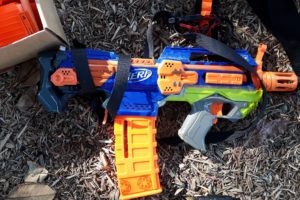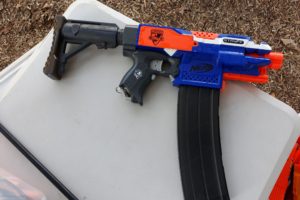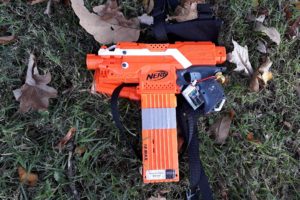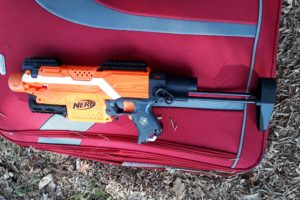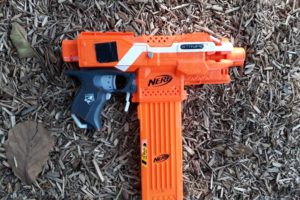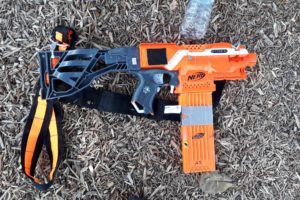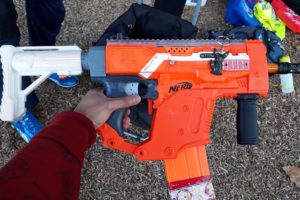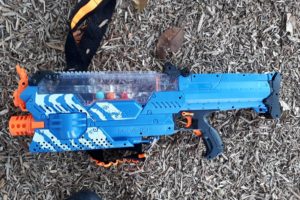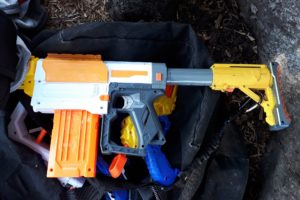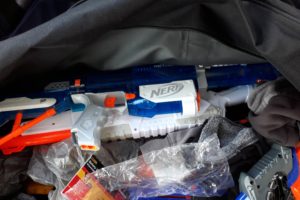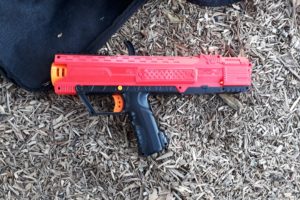
Nerf Game Report: Melbourne HvZ 2/6/18
June 9, 2018We tried out a couple of new things at today’s event, namely small shields, a reworked Mega Zombie, and some altered PvP rules.
All rules can be found here.
Blasters:
Note that while I do my best to cover all significant blasters, it is entirely possible that I missed or forgot to include some. Also note that I primarily cover/detail mods that affect functionality and performance.
Regular/Recurring:
Elite Rapidstrike (various internal setups) – full-auto, mag-fed flywheeler. Extremely effective against groups and in close quarters. Also capable of accuracy-by-volume at longer ranges. Goes through ammo quite quickly if not handled with discipline.
Elite Stryfe (various internal setups) – semi-auto, mag-fed flywheeler. Excellent all-rounder, leaning towards ROF. Highly effective in the majority of HvZ encounters. A great starter blaster.
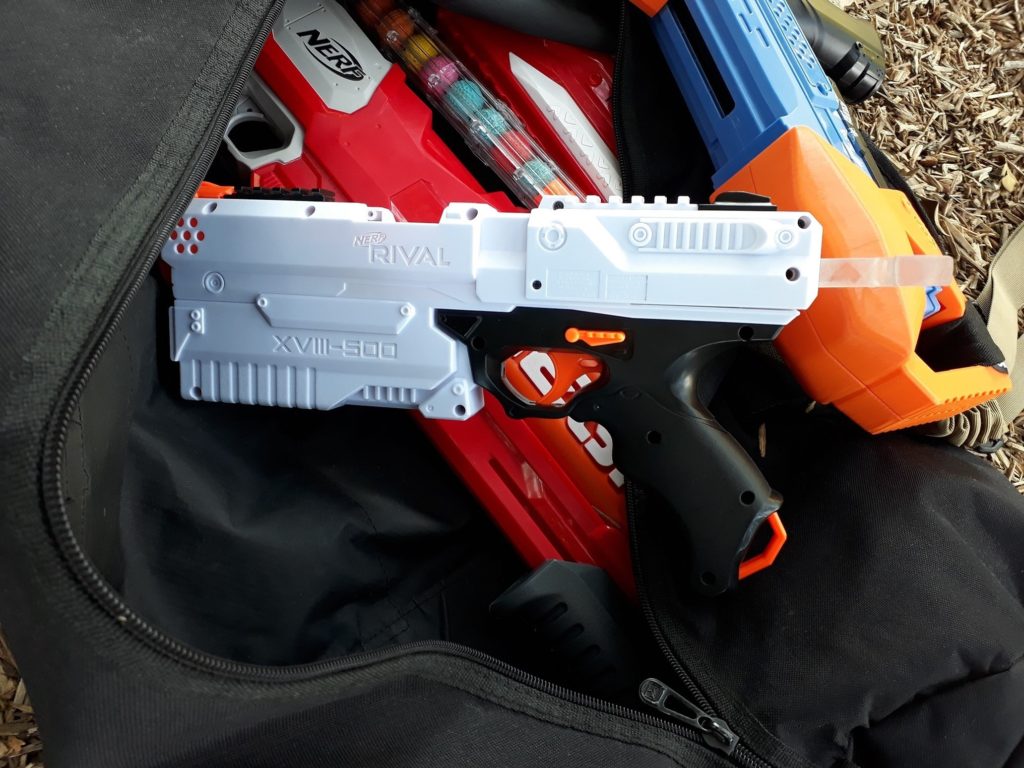 Rival Kronos – slide-action, internal mag-fed springer. Quite powerful, effective up to around 15m. Internal mag makes top-ups very easy. Quite large for a sidearm-type blaster.
Rival Kronos – slide-action, internal mag-fed springer. Quite powerful, effective up to around 15m. Internal mag makes top-ups very easy. Quite large for a sidearm-type blaster.
Rival Nemesis – full-auto, hopper-fed flywheeler. Exceptionally effective for area denial, accuracy-by-volume, and against groups. Goes through ammo extremely quickly if not handled with discipline. Can be topped up reasonably quickly. Very bulky, but has a very high capacity.
Elite Retaliator/Modulus Recon MkII (various setups) – slide/pump-action, mag-fed springer. Solid all-round, leaning towards power and accuracy. Effective at longer ranges, however low ROF leaves it more vulnerable to groups.
ZS Sledgefire (singled) – break-action, single-shot springer. Quite powerful and accurate, effective at picking off zombies from longer range. Single-shot nature leaves it highly vulnerable to groups in close quarters.
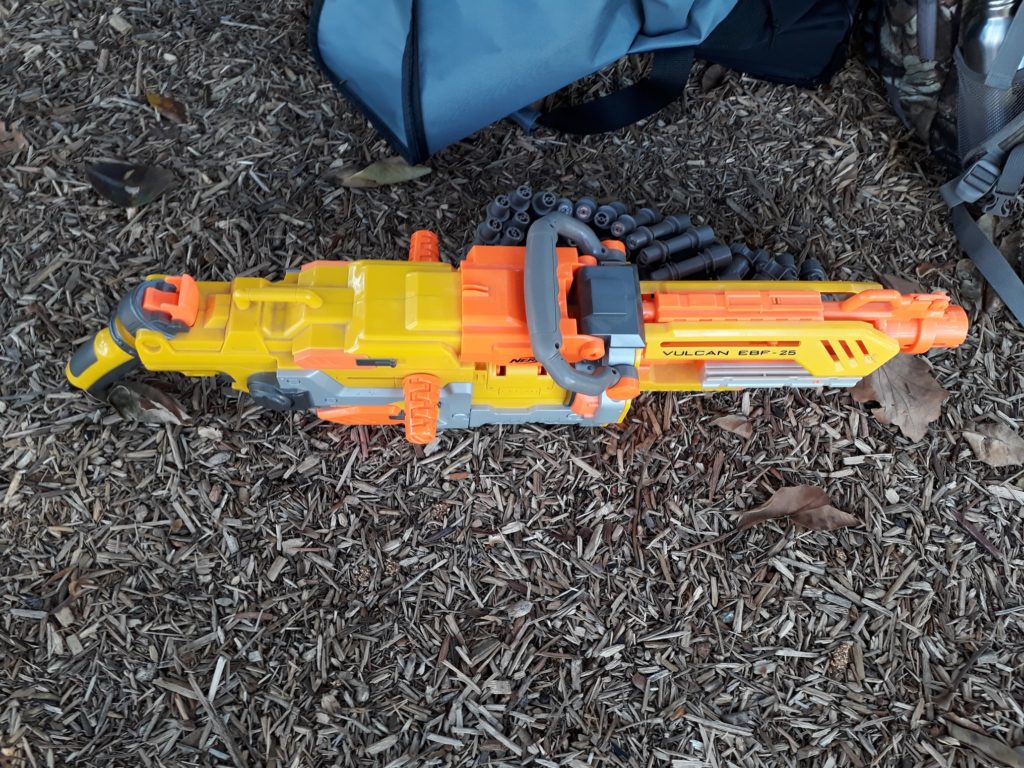 N-Strike Vulcan – full-auto, belt-fed springer. In stock form with stock belts, good only for style points. It is very large, bulky and unwieldy, with rather poor performance.
N-Strike Vulcan – full-auto, belt-fed springer. In stock form with stock belts, good only for style points. It is very large, bulky and unwieldy, with rather poor performance.
 N-Strike Stampede – full-auto, mag-fed springer. Outclassed by many other blasters in all aspects except cool factor, its firing sound is still one of the most distinct and coolest sounds you can get from a Nerf blaster.
N-Strike Stampede – full-auto, mag-fed springer. Outclassed by many other blasters in all aspects except cool factor, its firing sound is still one of the most distinct and coolest sounds you can get from a Nerf blaster.
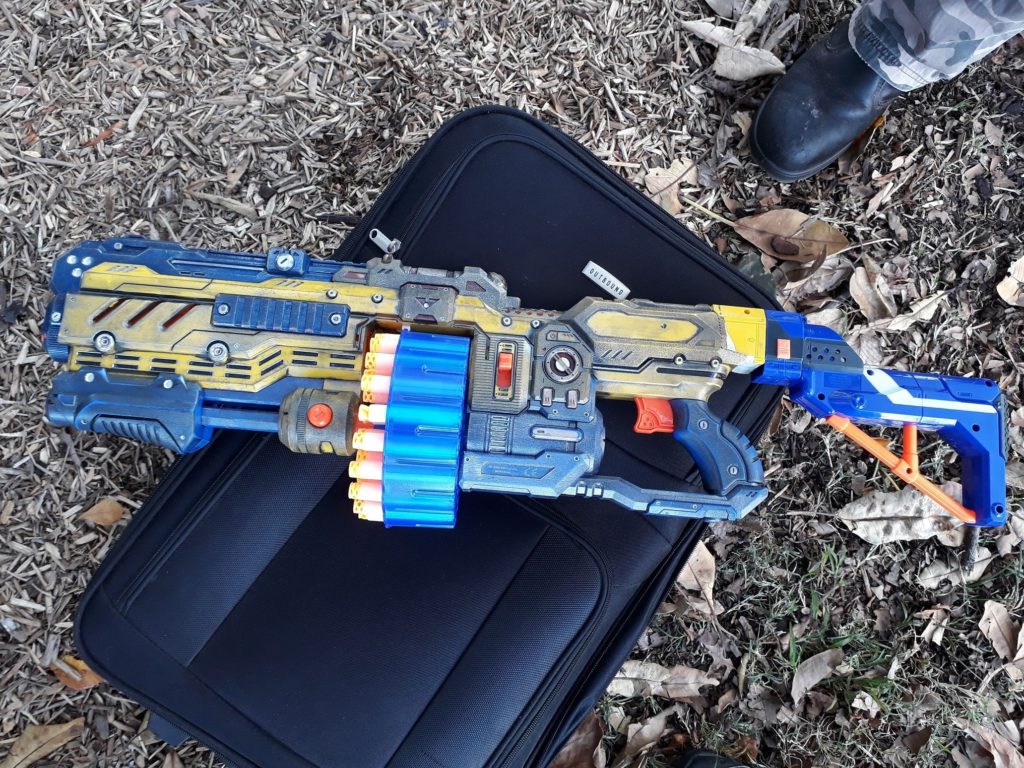 X-Shot Turbo Advance – pump-action, revolver springer. Very high capacity with solid ROF, good for scavenger/run-and-gun playstyles.
X-Shot Turbo Advance – pump-action, revolver springer. Very high capacity with solid ROF, good for scavenger/run-and-gun playstyles.
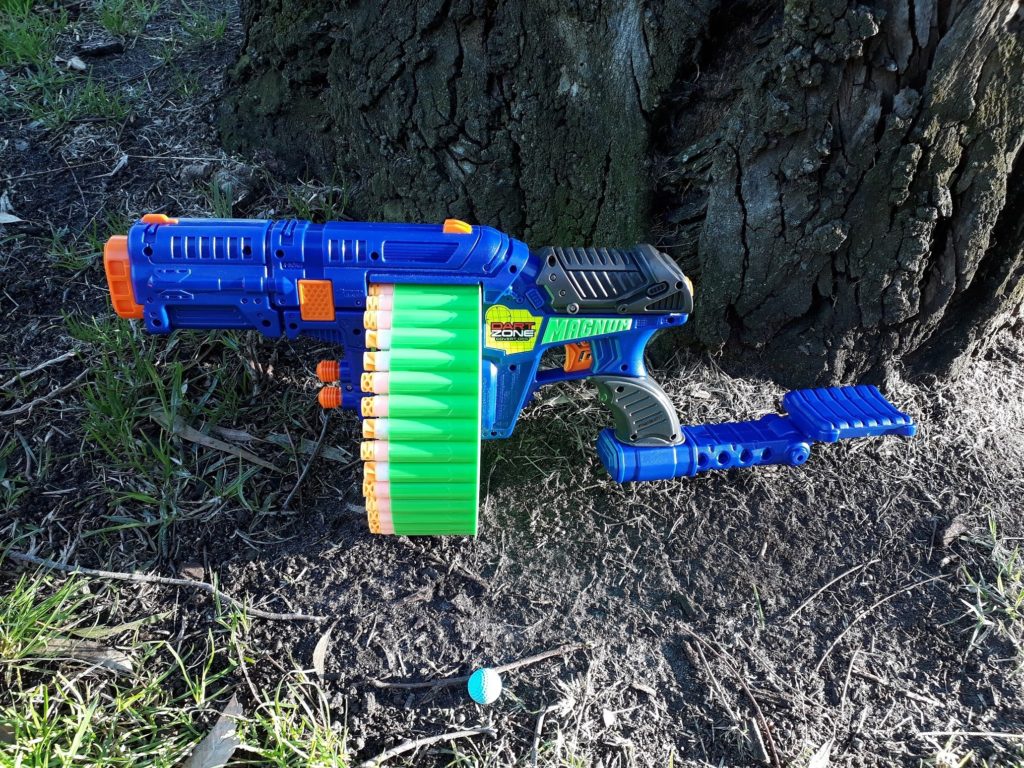 Dart Zone Magnum Superdrum – slide-action, revolver springer. Also very high capacity with decent ROF. Notable for its surprisingly good out-of-box power.
Dart Zone Magnum Superdrum – slide-action, revolver springer. Also very high capacity with decent ROF. Notable for its surprisingly good out-of-box power.
 Mega Doublebreach – pump-action, 2-Smart-AR springer. Incredibly large and excessive for what is just a two-shot Smart-AR blaster. Badly outclassed by just about every other Mega blaster.
Mega Doublebreach – pump-action, 2-Smart-AR springer. Incredibly large and excessive for what is just a two-shot Smart-AR blaster. Badly outclassed by just about every other Mega blaster.
New/Infrequent:
 Doomlands The Judge – pump-action, multishot revolver springer. Huge, bulky, heavy, all round just ridiculous. Its only draw is style factor, as it is incredibly impractical and outclassed in all respects by many blasters.
Doomlands The Judge – pump-action, multishot revolver springer. Huge, bulky, heavy, all round just ridiculous. Its only draw is style factor, as it is incredibly impractical and outclassed in all respects by many blasters.
Rival Apollo (with or without pump grip) – bolt/pump-action, mag-fed springer. Decent out-of-box power. Relatively low ROF and capacity hinder it against groups.
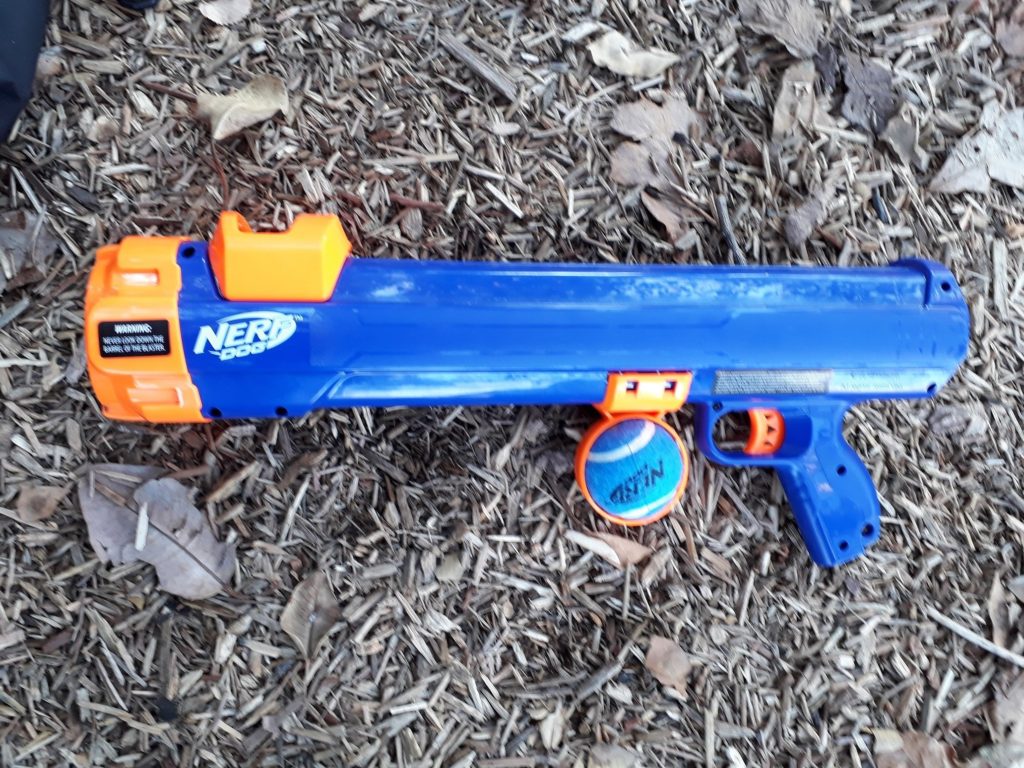 Nerf Dog Ball Launcher – slide-action, single shot slingshot. Maximum range of about 12m. Completely and utterly terrible at any kind of Nerf combat.
Nerf Dog Ball Launcher – slide-action, single shot slingshot. Maximum range of about 12m. Completely and utterly terrible at any kind of Nerf combat.
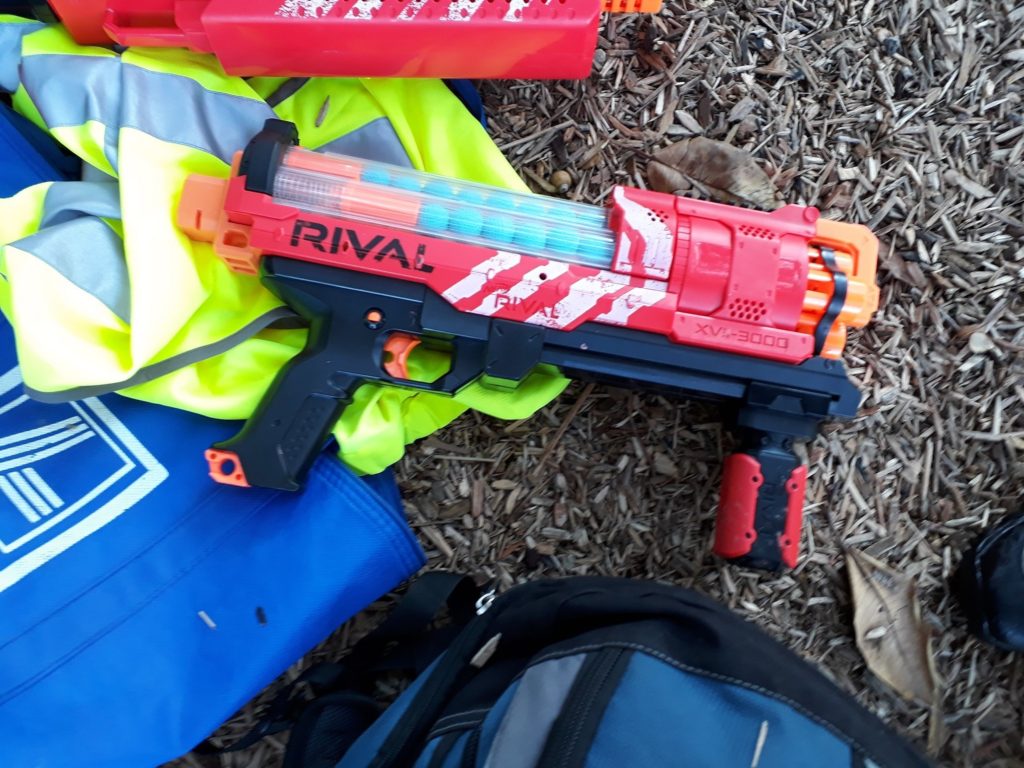 Rival Artemis – pump-action, internal mag-fed springer. A solid run-and-gun type blaster, good power and ROF, and very easily topped up.
Rival Artemis – pump-action, internal mag-fed springer. A solid run-and-gun type blaster, good power and ROF, and very easily topped up.
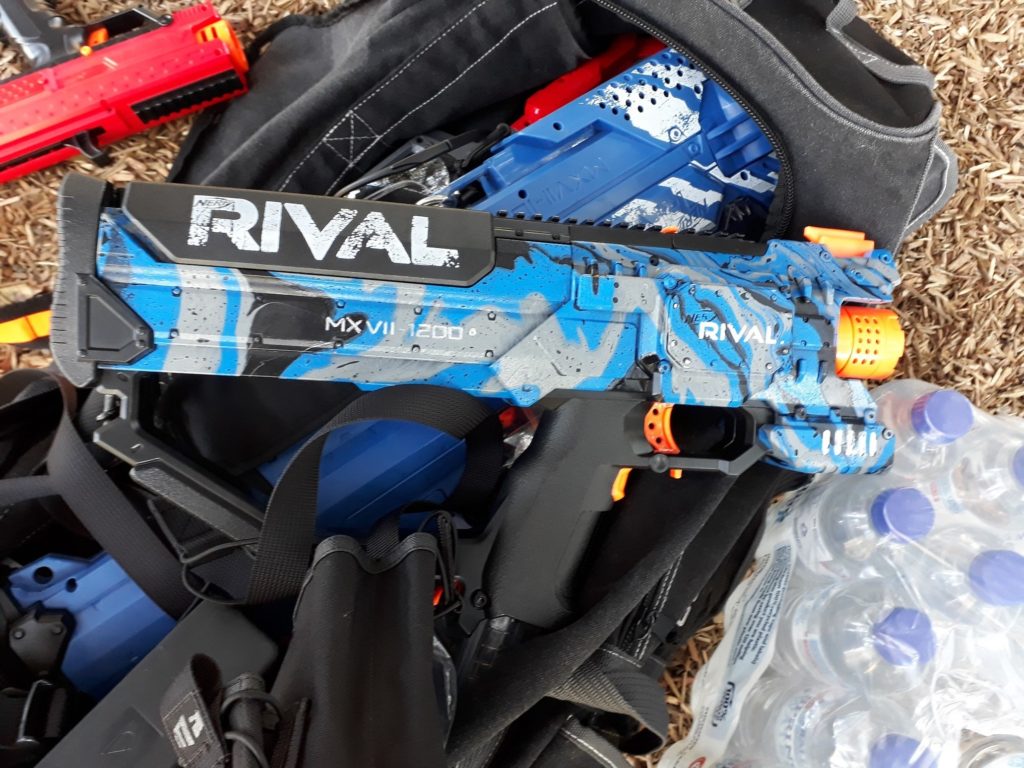 Rival Hera (rewired) – semi-auto, mag-fed flywheeler. Decent Rival all-rounder, limited primarily by the largest compatible Rival mag having only 12-ball capacity. Surprisingly bulky, but not too large.
Rival Hera (rewired) – semi-auto, mag-fed flywheeler. Decent Rival all-rounder, limited primarily by the largest compatible Rival mag having only 12-ball capacity. Surprisingly bulky, but not too large.
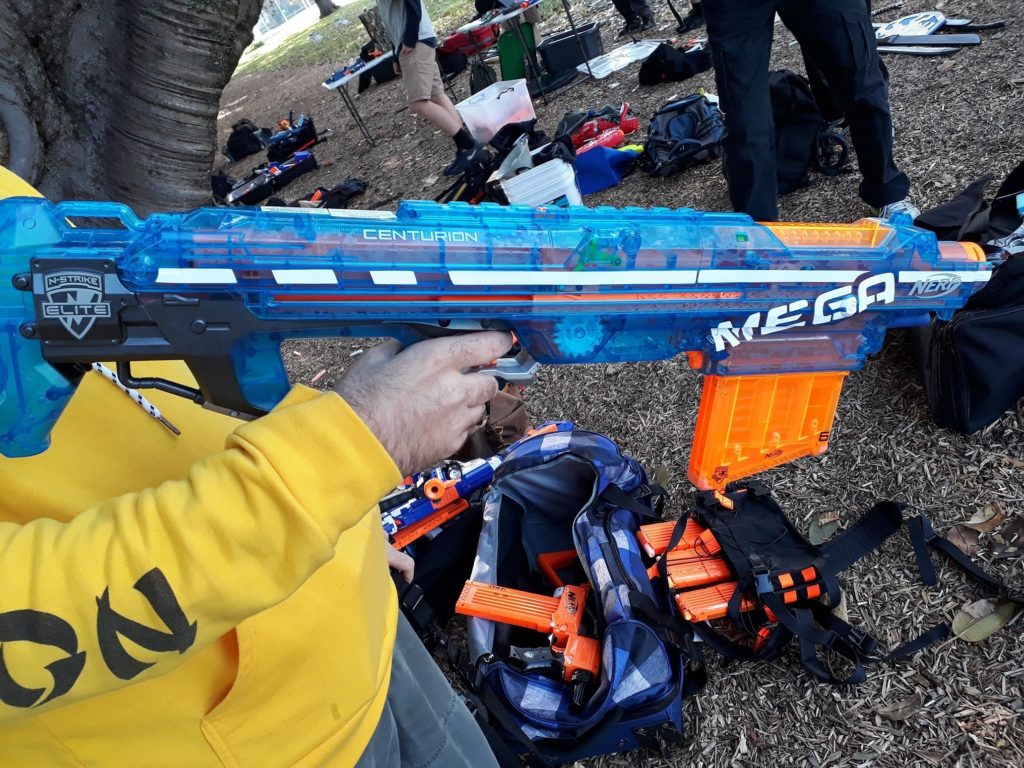 Mega Centurion – bolt-action, mag-fed springer. Used only because it was a Sonic Ice, which as far as I’m aware did not retail in Australia. Surprisingly powerful as it was an orange trigger model, but still nothing exceptional. Very large with a ridiculously long and awkward bolt action.
Mega Centurion – bolt-action, mag-fed springer. Used only because it was a Sonic Ice, which as far as I’m aware did not retail in Australia. Surprisingly powerful as it was an orange trigger model, but still nothing exceptional. Very large with a ridiculously long and awkward bolt action.
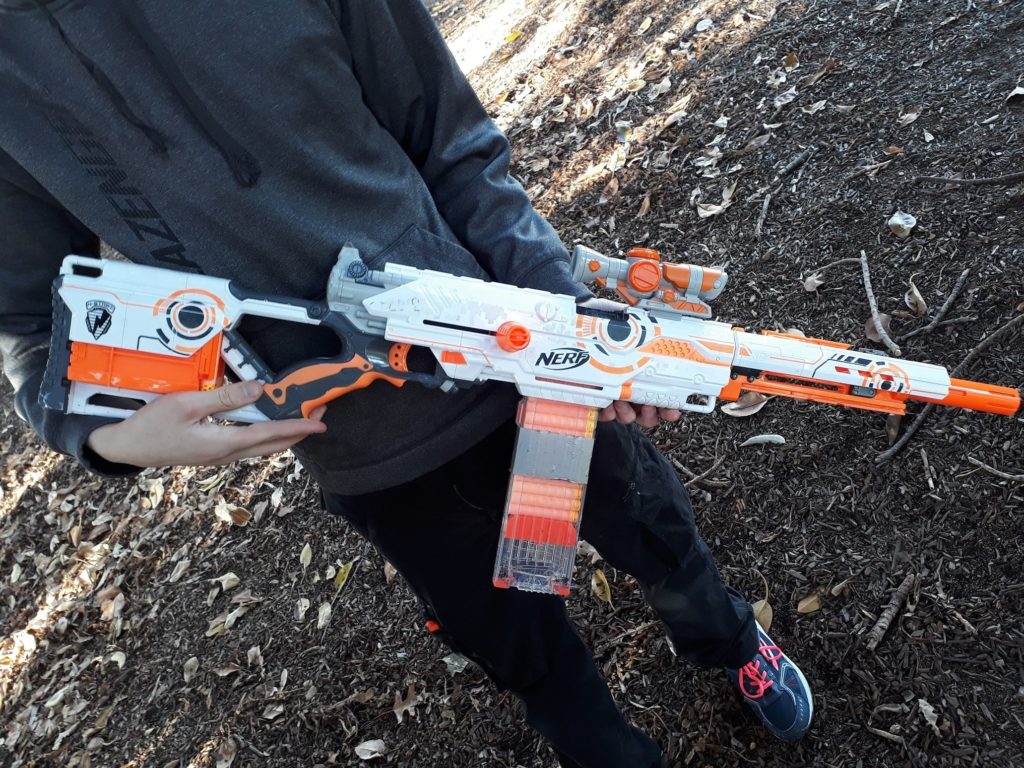 N-Strike Longstrike – bolt-action, mag-fed springer. Badly outclassed by most other blasters on this list, good only for aesthetics.
N-Strike Longstrike – bolt-action, mag-fed springer. Badly outclassed by most other blasters on this list, good only for aesthetics.
 We had a rather low player count today, peaking at about 25 but typically around 20 for most games. This month’s event seemed like there were a lot more newer, less experienced and less well equipped players relative to typically well armed veterans. It was also relatively cool, peaking around 15C or so.
We had a rather low player count today, peaking at about 25 but typically around 20 for most games. This month’s event seemed like there were a lot more newer, less experienced and less well equipped players relative to typically well armed veterans. It was also relatively cool, peaking around 15C or so.
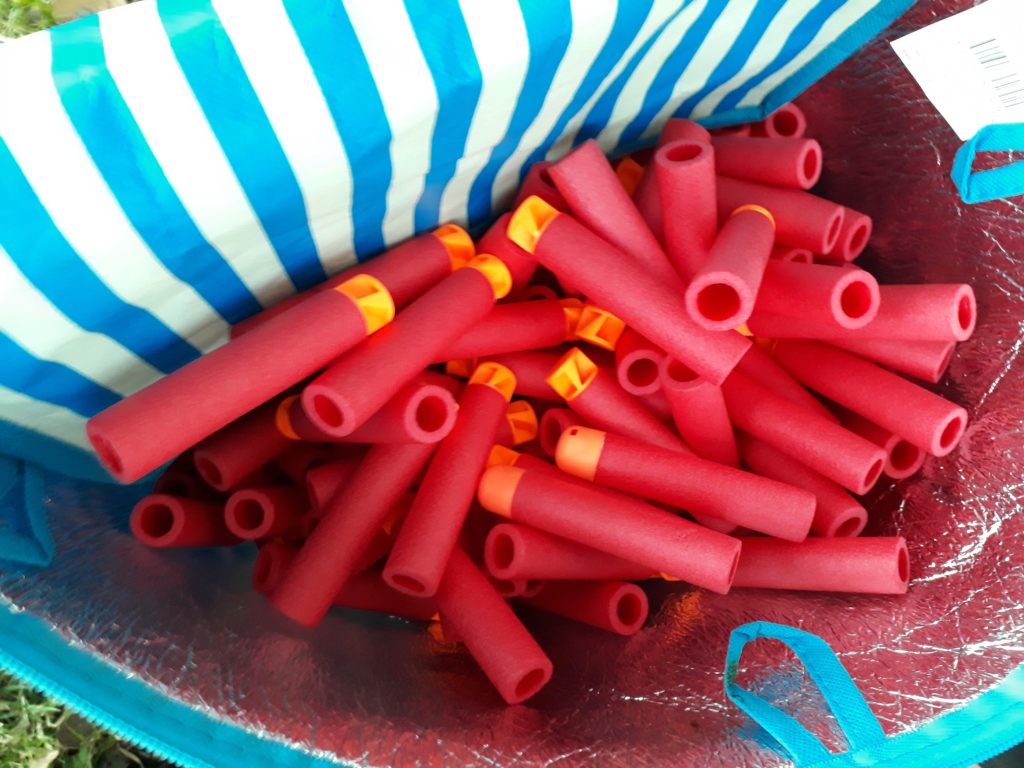 For this event, we had a number of new Lightake/NFstrike AccuMegas available, to coincide with the re-introduction of the Mega zombie (which I’ll discuss later). As I detailed in my review just before, at the cost of a little muzzle velocity, range and a heavier impact, AccuMegas are far more accurate and consistent than standard Nerf Megas. Given that they are also a lot cheaper to acquire than Nerf Megas, AccuMegas serve pretty well as a community Mega pool.
For this event, we had a number of new Lightake/NFstrike AccuMegas available, to coincide with the re-introduction of the Mega zombie (which I’ll discuss later). As I detailed in my review just before, at the cost of a little muzzle velocity, range and a heavier impact, AccuMegas are far more accurate and consistent than standard Nerf Megas. Given that they are also a lot cheaper to acquire than Nerf Megas, AccuMegas serve pretty well as a community Mega pool.
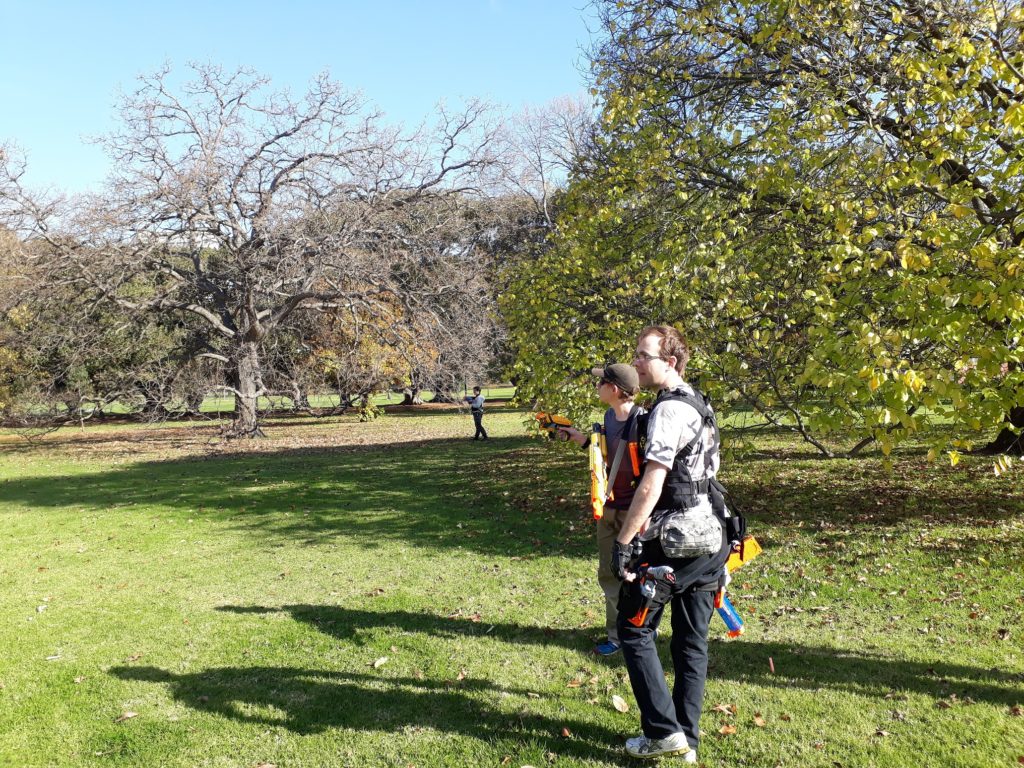 As always, we started with a Survival. For this first round, the zombies started with only melee and small shields, with the large shields and Husk being made available at 5 minutes. This warm-up period offers newbies in particular an opportunity to learn the game and get warmed up without having them face the most threatening zombies (large Tank and Husk) straight up.
As always, we started with a Survival. For this first round, the zombies started with only melee and small shields, with the large shields and Husk being made available at 5 minutes. This warm-up period offers newbies in particular an opportunity to learn the game and get warmed up without having them face the most threatening zombies (large Tank and Husk) straight up.
For the majority of this round, I stayed away from human groups, instead remaining alone typically in far off corners. This tactic worked very well, as I was able to largely avoid combat with zombies until the closing stages of the game, as the human numbers dwindled into single digits. A combination of firepower and speed allowed me to end up as the last survivor, whereupon I staged a final stand in the north-east corner, and allowed myself to be overwhelmed.
For the second round of Survival, zombies started with all mutations are per normal. This round, I decided to stick closer to the humans and thus the action. Though tags were much more frequent in this event than usual, the group I stuck with was mostly able to survive quite late into the game. During one particular zombie engagement just south of the tambark, our group was separated, so I ran north alone. I neared a pair of players, the second who I found out too late had just been tagged, failing to bring my blaster up to stun the first, who was a zombie. Having been tagged in my poor judgement, I joined the horde in cornering and tagging the remaining humans, who were mostly separated and easy to finish off.
 We then played a round of Space Pope. Due to the low player count, and relative lack of veterans, we decided to leave out the Traitor. Early on in the round, I came across the grenade. As soon as Tanks were released at 5 minutes, I chose one Tank to focus on. I chased them around the tambark, making sure they couldn’t get very far if they charged in, relying on other humans to fend off the other Tank and zombies. Throughout the game however, the zombies were able to get a few tags here and there, slowly whittling down the human group. Eventually, I was hit in the back of the neck by the Husk while chasing said Tank. Now a zombie, I participated in several charges against the weakened human group, though made little progress myself. We were able to tag the General with a few minutes remaining. Eventually, with human numbers dwindling rapidly, one of the zombies was able to tag the Space Pope with 5 seconds remaining for an incredibly close zombie victory.
We then played a round of Space Pope. Due to the low player count, and relative lack of veterans, we decided to leave out the Traitor. Early on in the round, I came across the grenade. As soon as Tanks were released at 5 minutes, I chose one Tank to focus on. I chased them around the tambark, making sure they couldn’t get very far if they charged in, relying on other humans to fend off the other Tank and zombies. Throughout the game however, the zombies were able to get a few tags here and there, slowly whittling down the human group. Eventually, I was hit in the back of the neck by the Husk while chasing said Tank. Now a zombie, I participated in several charges against the weakened human group, though made little progress myself. We were able to tag the General with a few minutes remaining. Eventually, with human numbers dwindling rapidly, one of the zombies was able to tag the Space Pope with 5 seconds remaining for an incredibly close zombie victory.
After a lunch break, we played another round of Space Pope. With a slight increase in player numbers and in particular having more experienced players, we re-implemented the Traitor for this round. We also implemented slightly altered human vs human rules. If a human is hit by a dart, they are stunned for 15 seconds. They cannot move or shoot while stunned.
Right from the beginning, one of the humans opened fire on the rest of the human group, however they were quickly stunned and then grenaded. As it turned out, this human was not the Traitor, simply a player who wanted to introduce a little chaos into the game. Shortly afterwards however, the Traitor revealed themselves and used their tag on the General. With the Space Pope now revealed, the zombies were able to focus their efforts. Repeated zombie charges were able to whittle down the human group, and with around 5 minutes remaining, the zombies were able to tag the Space Pope.
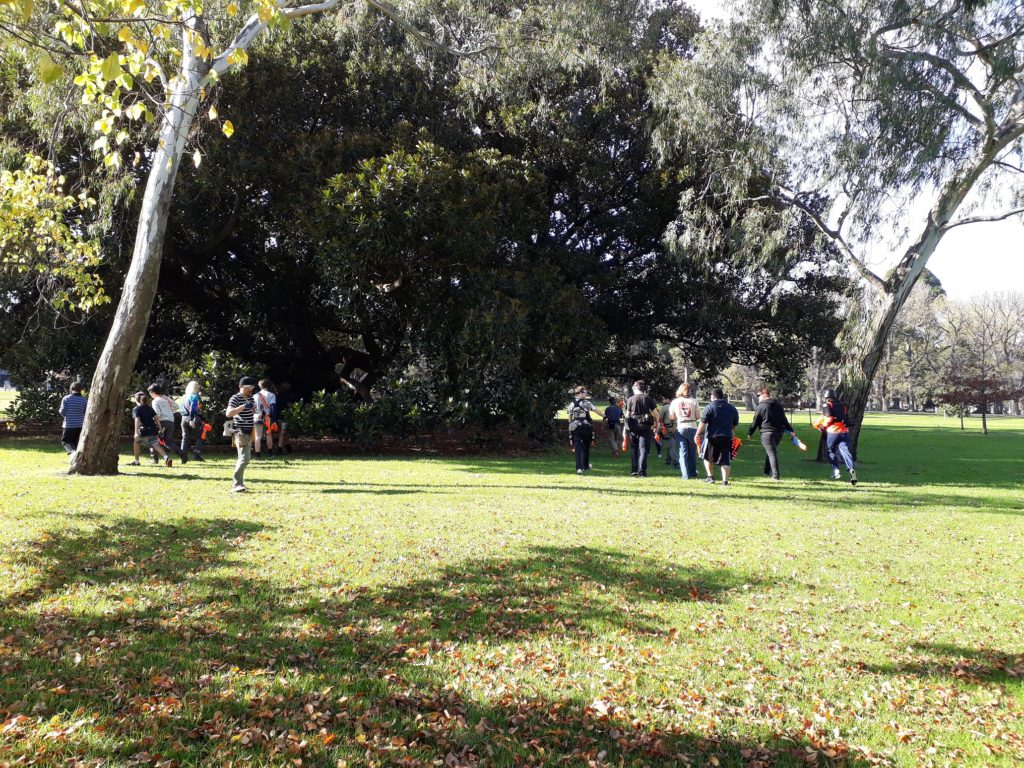 Next up was a round of VIP Survival. Each VIP was assigned a particular blaster. The Tank VIP was given a Doublebreach, while the Husk VIP was given the ball launcher. The zombies started with melee and small shields. I was chosen as a starter zombie.
Next up was a round of VIP Survival. Each VIP was assigned a particular blaster. The Tank VIP was given a Doublebreach, while the Husk VIP was given the ball launcher. The zombies started with melee and small shields. I was chosen as a starter zombie.
Within a couple of minutes, the zombies had managed to tag several straggler humans, and had already begun to push the human groups around. The VIPs largely remained well protected and on the move, however the zombies were relentless and were able to whittle down the human group surprisingly fast. With zombie numbers steadily growing, the human groups were quickly reduced to a couple of survivors. Rather entertainingly, the VIPs were two of the last four or so humans left, and the zombies were able to clean up the rest of the humans without any extra upgrades.
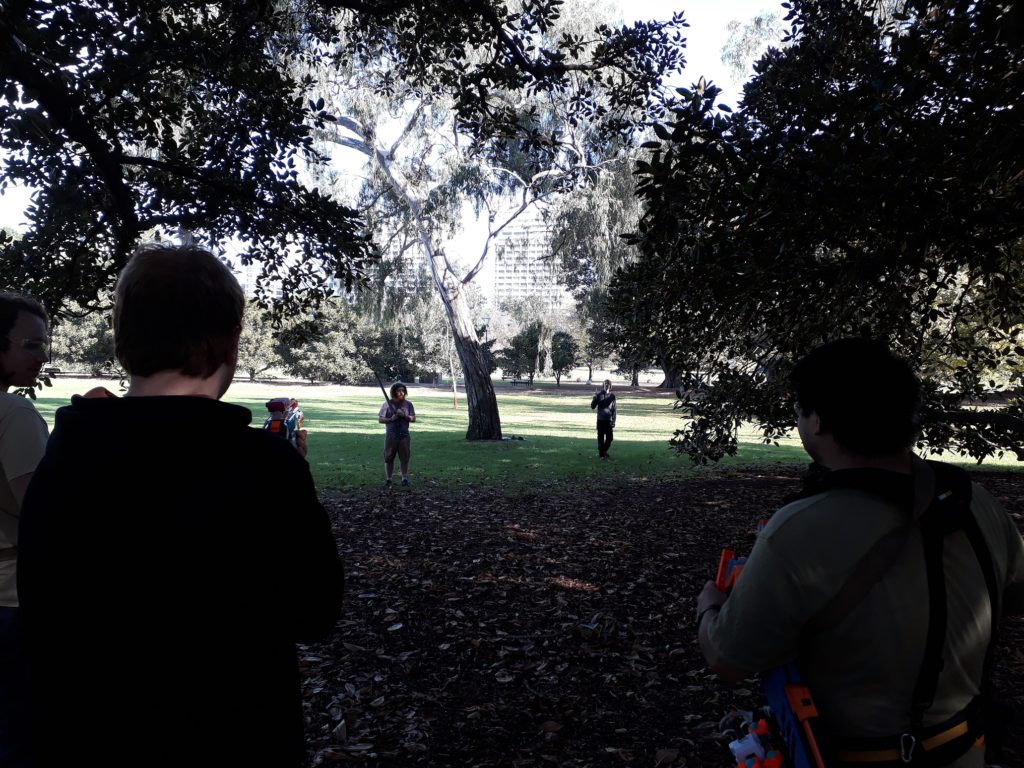 We then played a round of Survival, introducing the reworked Mega Zombie. This iteration of the Mega is unable to tag humans, however can revive zombies with a 3 second revive, and a 10 second cooldown. As suggested by their name, they can only be stunned by Mega darts.
We then played a round of Survival, introducing the reworked Mega Zombie. This iteration of the Mega is unable to tag humans, however can revive zombies with a 3 second revive, and a 10 second cooldown. As suggested by their name, they can only be stunned by Mega darts.
In early game, the Mega zombie allowed the fledgling horde to push forward much more frequently, in particular allowing the Tanks to advance more regularly. This extra pressure did seem to speed up early game a little, since it was also much easier to catch humans off guard. I was able to survive until the end of the game by joining the human group where necessary, but breaking off when convenient. Eventually, I became too tired to run, and allowed myself to be tagged by the ball launcher Husk.
The typical tactic for dealing with the Mega Zombie was to stun all regular zombies, quickly re-stun the zombie that the Mega revives, then stun the Mega and quickly retreat. While this worked well earlier in the game, as the game went on and the zombie horde grew, it became increasingly difficult to stop the Mega zombie. On top of being stunnable only by Mega darts, the Mega zombie is typically found in the middle of a horde, out of the line of fire but close enough to revive front line zombies.
With a large zombie horde, without a particularly well armed and coordinated group, stunning every nearby zombie is practically impossible, especially with Tanks, the Husk and the Mega in play. Not to mention the necessity to switch to a Mega blaster just for the Mega zombie, since most players run dart-firing or Rival blasters. As such, the Mega is practically free to run rampant in late game. Although one revive every 13 seconds is not a huge deal in late game, having to deal with one extra Tank charge when already tired, low on ammo and low on allies is a little annoying and in my opinion a bit unnecessary. I think allowing the Mega zombie to be stunned by regular darts (along with an appropriate rename), perhaps also with cooldown tweaks, would be much more fun to play against without impacting human-zombie balance significantly.
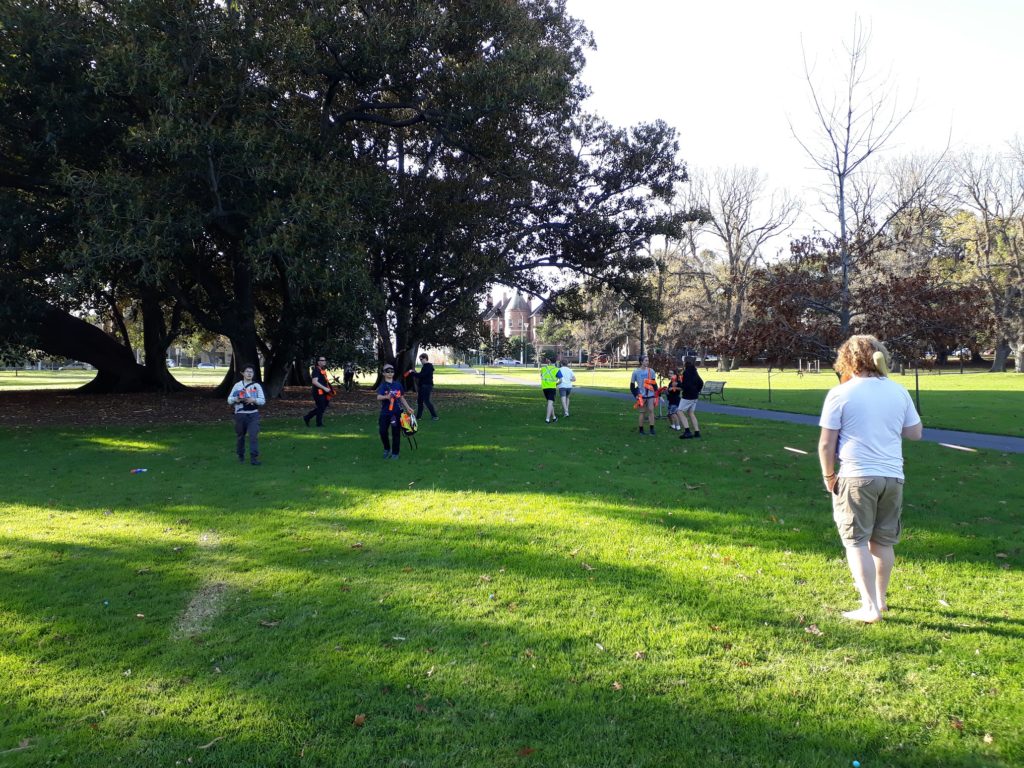 We ended the day with another Space Pope round. We started with a few more zombies than usual, with an unexpectedly low human count. I did not play in this round as I was too tired from the rest of the day’s games.
We ended the day with another Space Pope round. We started with a few more zombies than usual, with an unexpectedly low human count. I did not play in this round as I was too tired from the rest of the day’s games.
The Traitor revealed themselves early in this game, quickly moving back and opening fire on the human group. Due to a rules misunderstanding however, they left themselves vulnerable to human counterattack and were quickly stunned and grenaded. Nonetheless, due to the higher-than-usual starting ratio, and relative lack of humans, the zombies were able to make significant inroads into the human defences even from early on. A quick tag here and there made much more of an impact than with larger human groups. Tags became even more frequent once Tanks were released, at which point it became a bit of a slaughter. Eventually, the Space Pope was the only human left, and was tagged at around the 10 minute mark.
With fewer, less experienced and less well equipped players, the Traitor is much less of a necessity in Space Pope. Without the typical level of experience and firepower, it is far easier for the zombies to achieve a few tags here and there, and whittle down the human group. With much more favourable attrition rates, a zombie victory is much more feasible, and the Traitor is not required to give zombies a reasonable chance. Additionally, trying to discreetly reveal the Space Pope’s identity to the humans is still quite risky, since any human who knows and is then tagged, can reveal the information to the zombies.
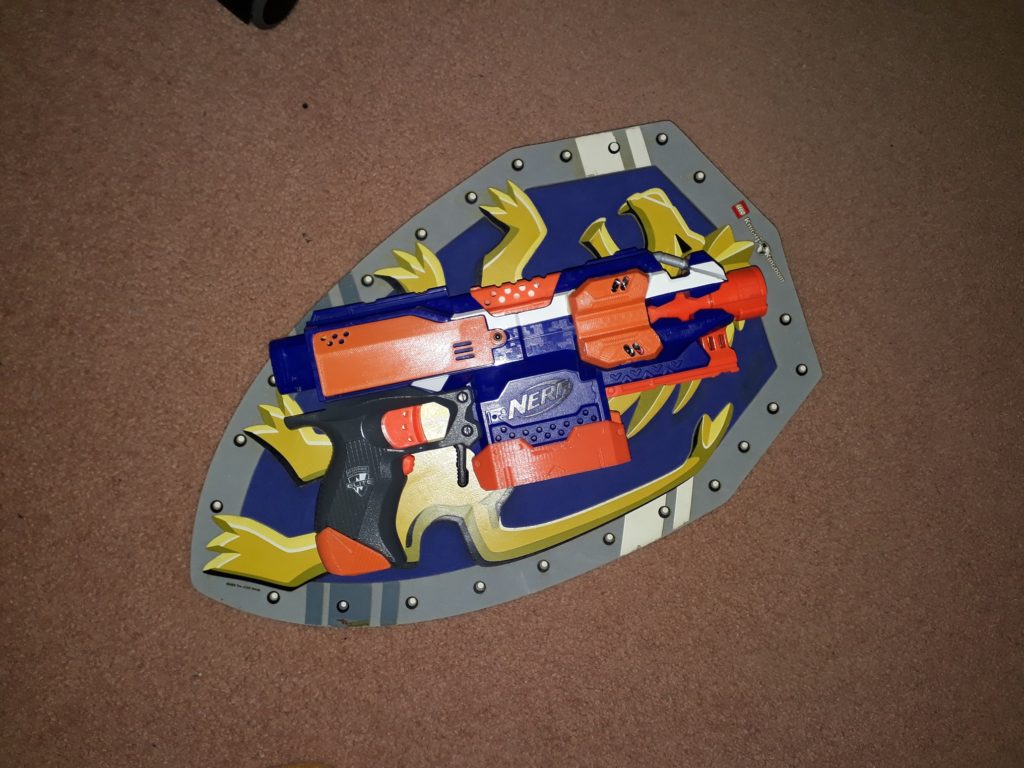 In every gamemode, we made two small shields available for small Tanks at all times, akin to melee. These shields, not that much bigger than a Stryfe, offered zombies a small amount of protection – far more than any melee but far less than the shields of large Tanks. The small shields are large enough to cover most of the torso of a teenager/small adult, but little else.
In every gamemode, we made two small shields available for small Tanks at all times, akin to melee. These shields, not that much bigger than a Stryfe, offered zombies a small amount of protection – far more than any melee but far less than the shields of large Tanks. The small shields are large enough to cover most of the torso of a teenager/small adult, but little else.
These small shields did not appear to have a major impact on the balance of the game. They could be used to effectively block most upper body shots, however the head, lower torso and limbs of the zombie are typically all left exposed. In close quarters, they offered zombies an advantage over lone humans with slower firing blasters, however groups of humans, or humans with high ROF blasters, could easily mow down these small Tanks. At longer range, they also allow zombies to close the distance more safely, though of course at this range they are still a non-threat. Perhaps most importantly however, these shields are far easier to run with than the large shields.
For some rounds, the ball launcher was used as a second or replacement Husk. With a maximum range of around 12m, but an effective range of maybe 6m due to low projectile speed, it was a bit useless and didn’t remotely compare to the standard Mega Vortex Howler Husk.
You can find the same post on my own blog: Outback Nerf
